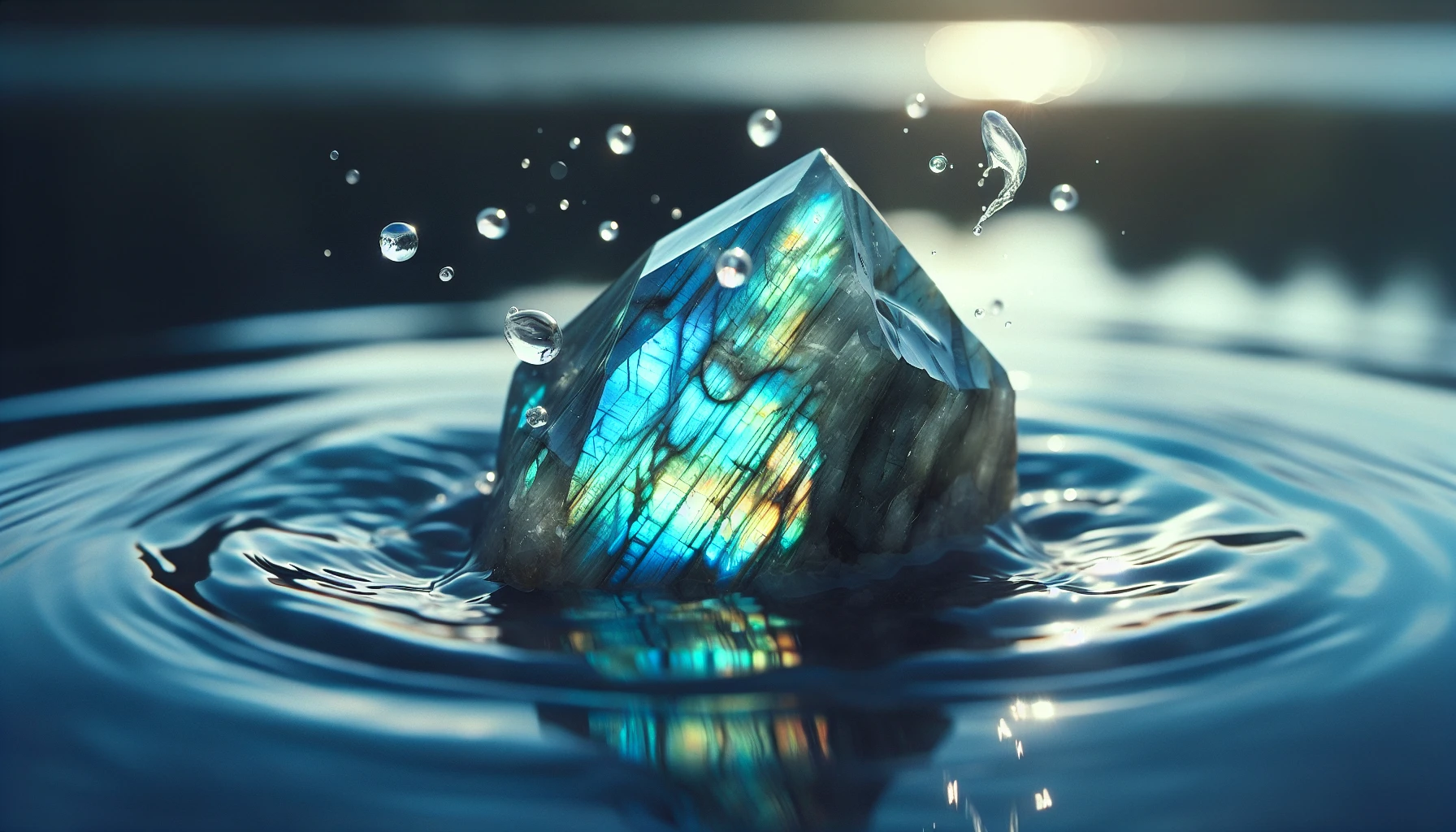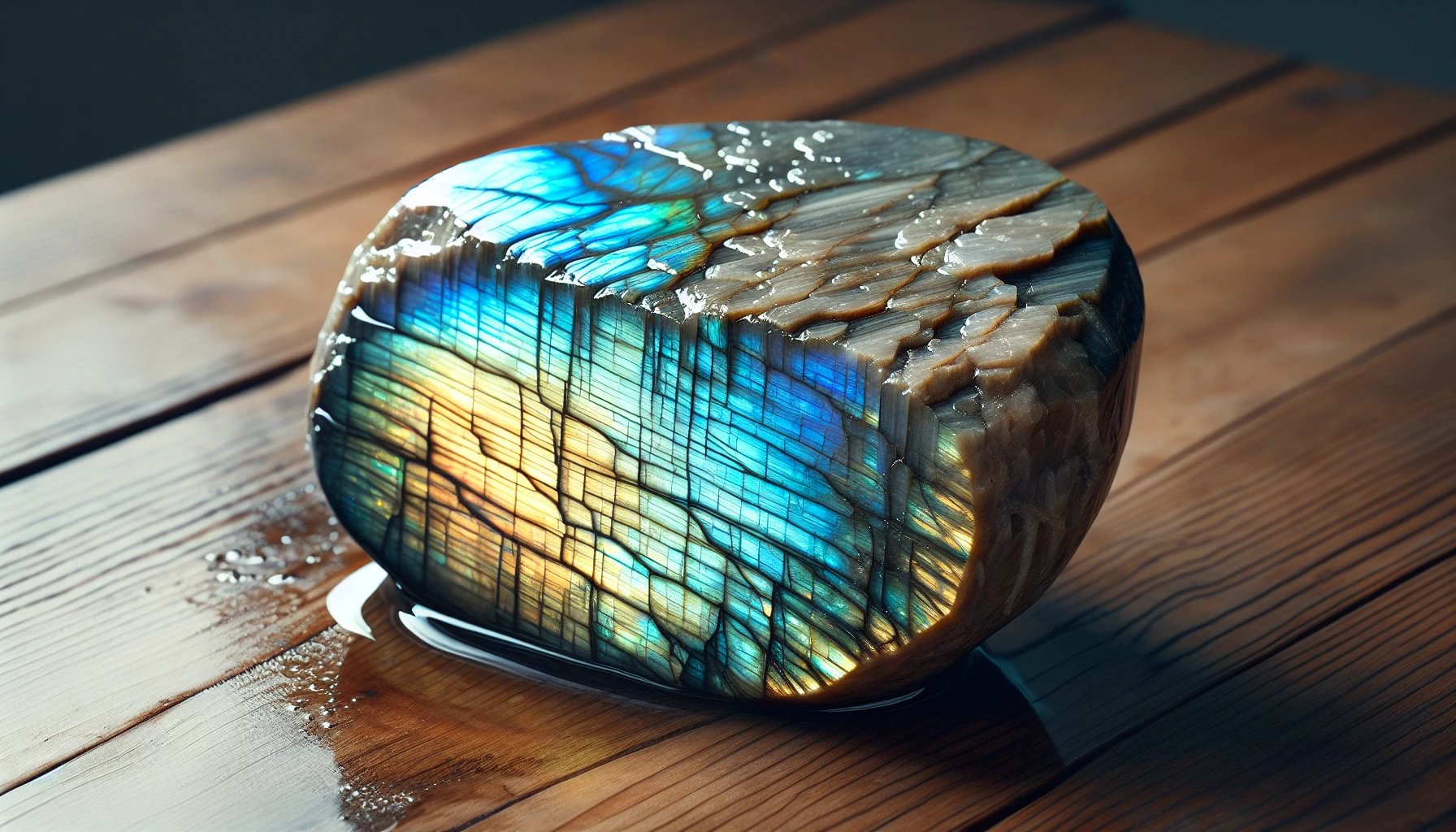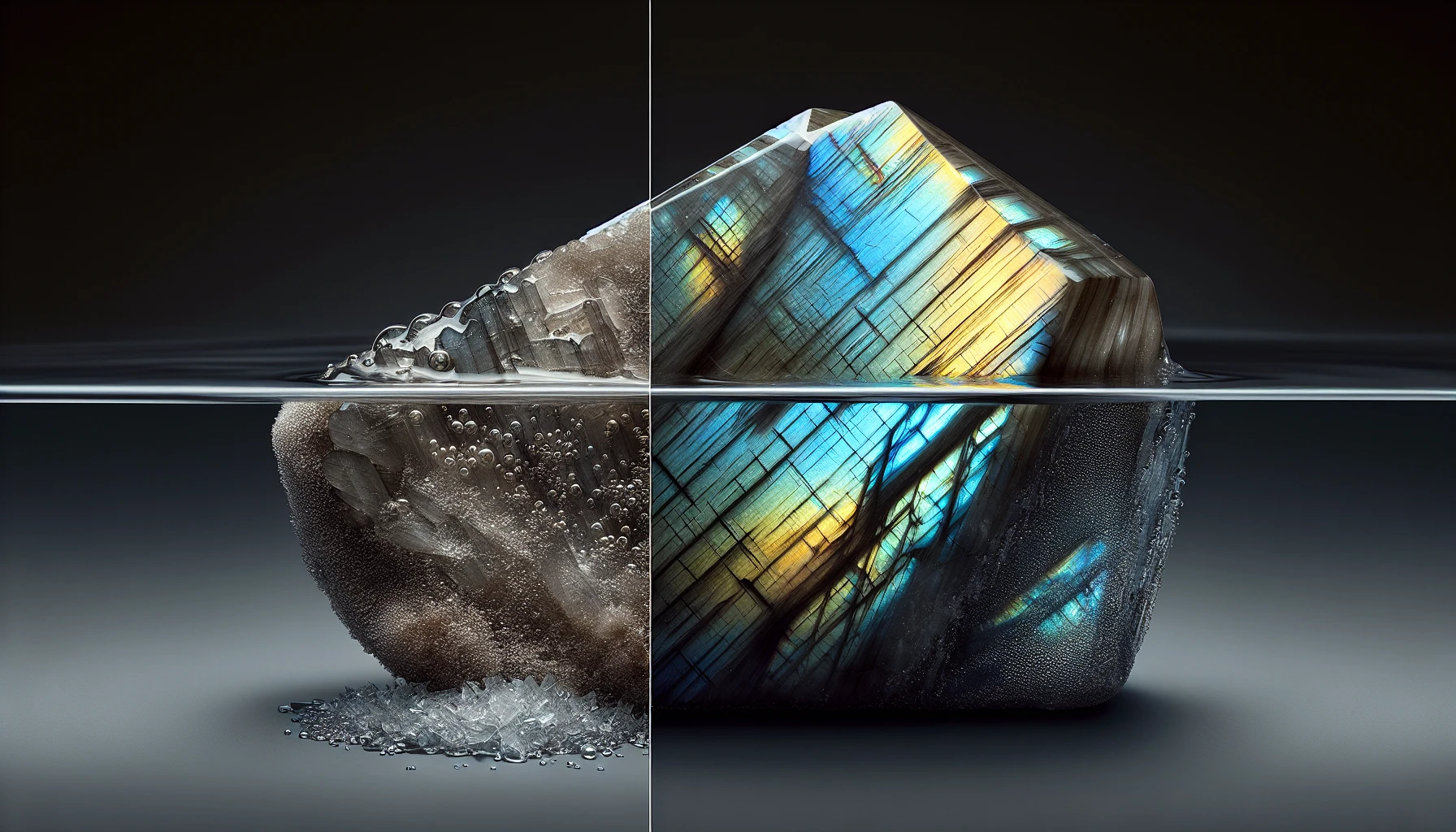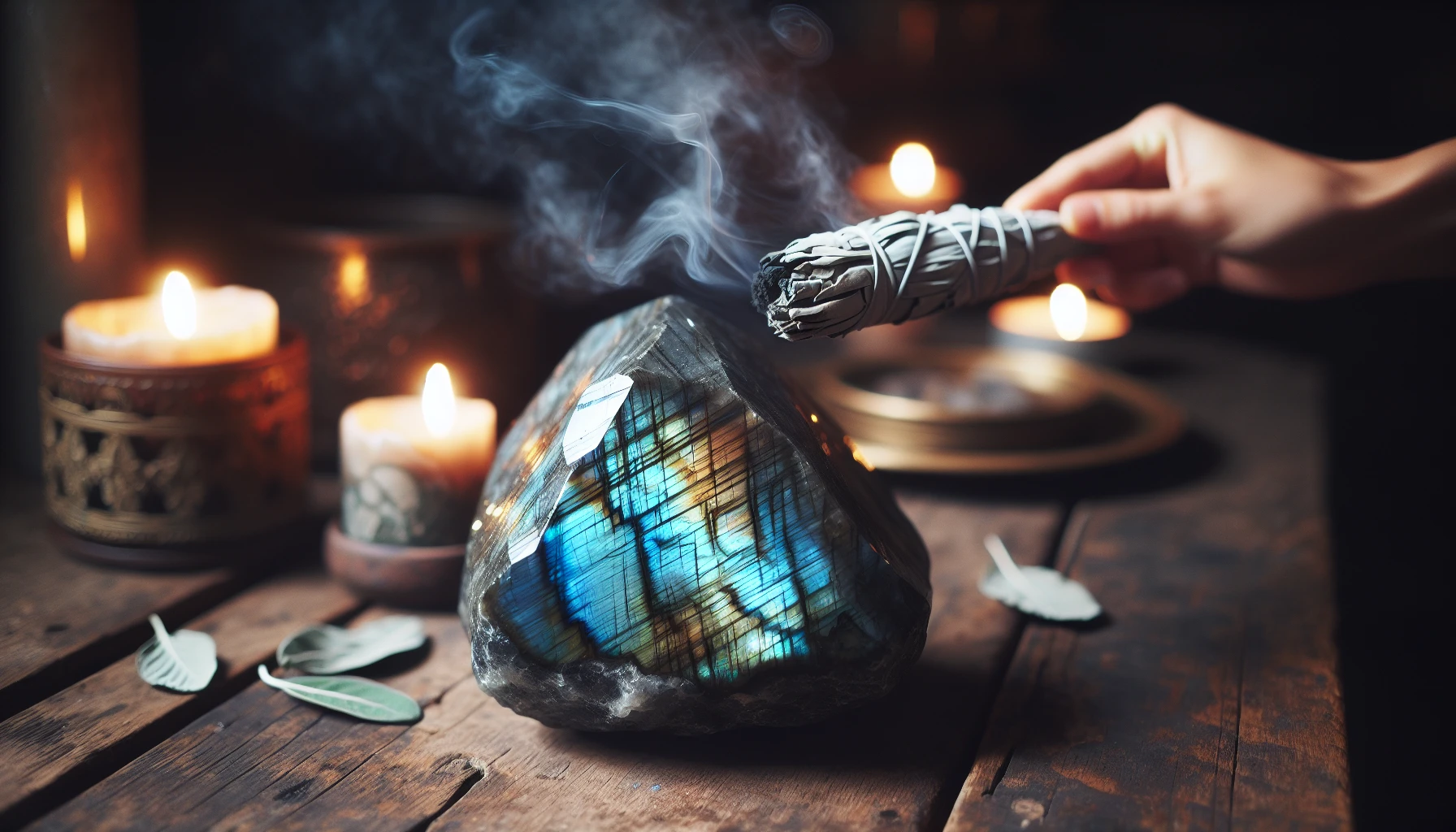Yes, Labradorite can go in water because it’s a hard mineral ranking 6 to 7 on Moh’s hardness scale.
Imagine walking along a rocky shoreline, stumbling upon a seemingly ordinary stone, only to discover a hidden world of vibrant colors and iridescence shimmering beneath the surface. This magical experience is akin to discovering the captivating beauty of Labradorite, a powerful and intriguing crystal with unique properties. Revered for its ability to foster transformation and self-discovery, Labradorite has inspired countless crystal enthusiasts to explore its depths and unlock its potential.
In this blog post, we will delve into the fascinating world of Labradorite, answering questions about its interaction with water, such as “can Labradorite go in water?”, proper care for Labradorite jewelry, safe cleansing methods, and tips for identifying genuine Labradorite. Let’s embark on this journey together and uncover the mysteries of this enchanting crystal.
Key Takeaways
- Labradorite can be submerged in water, but it is important to limit its exposure and handle with care.
- Fresh water is better for Labradorite than salt water. Cleanse using sage smudging, moonlight charging or other crystals.
- Extended exposure to direct sunlight should be avoided as it may lead to fading of color and iridescence.
Can Labradorite Be Submerged in Water?

Yes, Labradorite can be submerged in water but there are some important considerations. Although Labradorite is a relatively hard mineral, ranking 6-7 on the Moh’s hardness scale, prolonged exposure to water can still adversely affect its appearance and texture.
Just as with its cousin, lapis lazuli, you should carefully control how Labradorite is exposed to water.
Short-term Exposure
Short-term exposure to water is generally safe for Labradorite. However, you need to dry the stone completely before storing it to prevent any potential rough edges or damage. After a quick rinse or accidental splash, simply pat the stone dry with a soft cloth or allow it to air dry.
This brief exposure to moisture will not significantly affect the stone’s appearance or energy, including any potential negative energy.
Long-term Exposure
While short-term exposure to water is relatively harmless, long-term exposure of water for Labradorite is another story. Prolonged immersion in water can cause Labradorite to lose its shine, color, and iridescence, making it less attractive and effective. Over time, microscopic fissures may become visible cracks in the surface of the stone.
To preserve the allure and potency of your Labradorite, avoid prolonged exposure to water and use alternative methods to cleanse Labradorite that will be discussed later.
The Impact of Water on Labradorite’s Appearance

Water can greatly affect the appearance of Labradorite. Discoloration, loss of iridescence, and the formation of tiny fissures are all potential consequences of water exposure. The captivating play-of-color that makes Labradorite so mesmerizing can be diminished or even lost if the stone is subjected to water for extended periods. To keep your Labradorite’s striking appearance, limit its exposure to water and adhere to appropriate care guidelines.
The effects of water exposure on Labradorite are not instantaneous, but rather the result of a gradual process. Prolonged contact with water can weaken the stone’s structure, causing a dull and discolored appearance. Furthermore, the protective coating on the surface of the Labradorite may be lost when exposed to water. To keep your Labradorite looking its best, it’s crucial to handle it with care and avoid unnecessary contact with water.
Salt water vs. Fresh water: Which is Better for Labradorite?

When it comes to water exposure, not all water is created equal. There is a distinct difference between salt water and fresh water, and how they interact with Labradorite. Fresh water is generally safer for Labradorite, as it does not contain any corrosive elements that could potentially damage the stone. On the other hand, salt water can be corrosive and damaging to the stone due to its content of elements that can corrode minerals at a faster rate than regular water.
To preserve the durability and attractiveness of your Labradorite, follow these steps:
- Avoid immersing it in salt water.
- If your Labradorite does come into contact with salt water, be sure to rinse it thoroughly with freshwater.
- Pat it dry with a soft cloth.
By putting labradorite in a safe environment and taking these precautions, you can protect your Labradorite from the potentially damaging effects of salt water exposure.
Caring for Your Labradorite Jewelry
The right care for your Labradorite jewelry is needed to keep its charm and functionality. To keep your Labradorite jewelry looking its best, follow these tips:
- Avoid wearing labradorite jewelry in the shower or bath. The combination of water, soap, and potential impacts from everyday wear can cause damage to the stone and its setting.
- Instead, remove your Labradorite jewelry before bathing or swimming.
- Store it in a safe, dry place when not in use.
When it comes to cleaning your Labradorite jewelry, gentle is the way to go. Use the following steps to carefully clean your jewelry:
- Use a soft cloth.
- Apply a small amount of mild dish soap to the cloth.
- Gently wipe the Labradorite stone and its setting.
- Rinse the jewelry with clean water.
- Dry the jewelry thoroughly with a soft cloth.
Avoid using harsh chemicals or abrasive materials, as these can damage the stone and its setting. Regular cleaning with a gentle touch will keep your Labradorite jewelry looking beautiful and functioning at its best for years to come.
Safe Cleansing Methods for Labradorite Crystals

While it is needed to avoid water to retain the allure and effectiveness of your Labradorite, you can use a few safe cleansing techniques to take care of your stone. These methods include smudging with sage, charging in moonlight, and utilizing other crystals for energy transfer.
Each method provides a distinctive way to cleanse and recharge your Labradorite, keeping it a potent and useful instrument in your spiritual pursuit.
Smudging with Sage
Smudging with sage is a popular and effective method of cleansing Labradorite crystals. The purifying smoke from burning sage can help remove negative energies and accumulated negativity from your stone. To smudge your Labradorite, simply follow these steps:
- Burn a sage bundle in a fire-safe dish.
- Ensure that the crystal is enveloped by the cleansing smoke for about 30 seconds.
- Open windows to allow the smoke to escape, carrying away any absorbed negative energies from your stone.
This age-old practice of smudging with sage is not just useful for cleansing Labradorite but can also purify other crystals and your surroundings. By incorporating smudging into your crystal care routine, you can ensure that your Labradorite remains energetically cleansed and ready to support your spiritual growth.
Moonlight Charging
Charging your Labradorite in moonlight is another safe and effective cleansing and recharging method. The gentle energy of the moon can enhance the spiritual power of your stone, making it an excellent option for those looking to deepen their connection with Labradorite. To charge your Labradorite in moonlight, simply place the stone outdoors during a full moon or in a bowl of moon water. The moon’s gentle energy will cleanse and recharge your stone, preparing it for your next spiritual adventure.
Moonlight charging is not only effective for Labradorite but can also be used for most stones and crystals. By including moonlight charging in your crystal care routine, you can utilize the moon’s power to cleanse and recharge your spiritual tools, fostering a potent synergy for growth and transformation.
Using Other Crystals
Using other crystals, such as Quartz or Amethyst, can also help cleanse and amplify the energy of your Labradorite stones. These crystals are believed to absorb unwanted or stagnant energy from your Labradorite, acting as a clearing agent and amplifier for the stone’s energy. You can cleanse and recharge your stone without requiring water or direct sunlight by placing your Labradorite on a crystal cluster or in a bowl of crystal chips.
In addition to Quartz and Amethyst, other crystals such as Moonstone, Fluorite, and Astrophyllite can also be used to cleanse and amplify Labradorite’s energy. Experiment with different combinations of crystals to find the perfect synergy for your spiritual practice and personal growth.
Tips for Identifying Genuine Labradorite
As Labradorite grows in popularity, you should ascertain the authenticity of the stone you’re working with. To identify genuine Labradorite, examine its unique iridescence, hardness, and mineral composition. Genuine Labradorite is distinguished by its dark grey to grey-black color, along with its captivating and colorful play of light. This iridescence, which can range from blue and green to yellow and orange hues, is a defining feature of genuine Labradorite.
Another way to identify genuine Labradorite is to test its hardness, which should be approximately 6 on the Mohs hardness scale. Genuine Labradorite will also have a chemical composition that falls within the plagioclase series, a type of feldspar mineral, with a range between albite (NaAlSi3O8) and anorthite (CaAl2Si2O8). By examining these characteristics, you can confidently determine if your Labradorite is genuine and benefit from its powerful properties.
Know More About Labradorite
Labradorite, also known as the Labradorite gemstone, is a truly intriguing and potent crystal with a broad array of properties and applications. In the following subsections, we will delve deeper into some of the most commonly asked questions about most labradorite stones, providing you with the knowledge and confidence to make the most of this remarkable stone.
From understanding its relationship with water and sunlight to identifying genuine Labradorite and exploring its spiritual qualities, these subsections will provide valuable insight into the world of Labradorite, ensuring that you are fully equipped to harness the power of this transformative crystal.
Can Labradorite Get Wet?
Yes, Labradorite can get wet, but its unique appearance and effectiveness can be damaged by prolonged exposure to water. While the hardness of Labradorite (6-7 on the Mohs scale) makes it less susceptible to damage from moisture, it’s still important to avoid submerging your stone in water for extended periods.
If your Labradorite does get wet, simply pat it dry with a soft cloth or allow it to air dry. By taking these precautions, you can protect your Labradorite from potential damage caused by prolonged water exposure and ensure that it remains a powerful and effective tool in your spiritual journey.
Can Labradorite Be In the Sun?
Yes, Labradorite can be in the sun. Exposure to sunlight for brief periods won’t significantly harm Labradorite. However, excessive exposure to sunlight can cause the stone to lose its vibrant colors and captivating iridescence, making it less attractive and effective. To maintain the beauty and power of your Labradorite, it’s important to avoid exposing it to direct sunlight for extended periods.
It’s worth noting that Labradorite is a naturally dark stone, so it would take a considerable amount of time in direct sunlight to observe any fading. However, to ensure the longevity of your Labradorite, it’s best to err on the side of caution and limit its exposure to direct sunlight.
Does Labradorite fade In the Sun?
Yes, Labradorite’s color and iridescence may fade if exposed to sunlight for extended periods. The captivating play-of-color exhibited by Labradorite is produced by light bouncing and scattering off the layers of minerals within the stone. Prolonged exposure to sunlight can cause the gemstone’s vibrant colors to fade over time.
You should handle your Labradorite with care and minimize unnecessary contact with sunlight to maintain its striking appearance. By taking these precautions, you can ensure that your Labradorite remains a powerful and beautiful tool in your spiritual practice.
Can Labradorite Go in Salt?
No, Labradorite cannot go in salt. Avoid submerging Labradorite in salt water as it can corrode and damage the stone. Salt water can be particularly harmful to Labradorite due to the presence of salt, water, and oxygen, which can lead to corrosion of the stone over time. To maintain the beauty and effectiveness of your Labradorite, it’s important to avoid submerging it in salt water.
If your Labradorite does come into contact with salt water, be sure to rinse it thoroughly with freshwater and pat it dry with a soft cloth. By taking these precautions, you can protect your Labradorite from the potentially damaging effects of salt water exposure.
Is Labradorite Toxic?
labradorite, also known as labradorite crystal, is non-toxic and safe for use in crystal healing and spiritual practices. Its unique properties make it a popular choice for those looking to foster transformation, balance emotions, and increase self-confidence. Whether used in meditation, energy work, or simply as a beautiful piece of jewelry, Labradorite is a powerful and safe tool for personal growth and spiritual exploration.
As with any crystal, it’s important to handle Labradorite with care and follow proper guidelines for cleansing, charging, and storage. By taking these steps, you can ensure that your Labradorite remains a powerful and effective tool in your spiritual journey.
Summary
In conclusion, Labradorite is a fascinating and powerful crystal with a wide range of properties and uses. From understanding its interaction with water and sunlight to identifying genuine Labradorite and exploring its spiritual qualities, this blog post has provided valuable insight into the world of Labradorite. By following the guidelines and tips provided, you can harness the power of this transformative crystal and embark on a journey of self-discovery and spiritual growth.
May your exploration of Labradorite illuminate the path toward personal transformation and enlightenment, opening doors to new possibilities and a deeper understanding of the world around you.
Frequently Asked Questions About Labradorite In Water
Can you charge Labradorite with water?
Yes, it is possible to charge labradorite by rinsing it under running water and positioning it where it can absorb sunlight and moonlight over a 24-hour period. Other techniques such as placing in sunlight, moonlight, sound, smoke, or even breath may also be used.
How do you cleanse labradorite with water?
Cleanse your Labradorite stone by soaking it in a bowl of salt water, such as from the ocean, for up to 48 hours. This method utilizes the energy absorbing and negativity eliminating qualities of salt.
How can you tell if Labradorite is real?
You can tell if Labradorite is real by checking its hardness on the Mohs scale, feeling its temperature, observing its iridescence when rotated, noting that two directions of perfect cleavage intersect at approximately 86 degrees, and ensuring it doesn’t glow when exposed to UV light.
Can you wear Labradorite all the time?
You can wear Labradorite all the time with proper setting and care, since it ranks 6-7 on Moh’s hardness scale.
Can Labradorite be submerged in water?
Labradorite can be temporarily submerged in water, but prolonged exposure should be avoided to preserve its appearance.